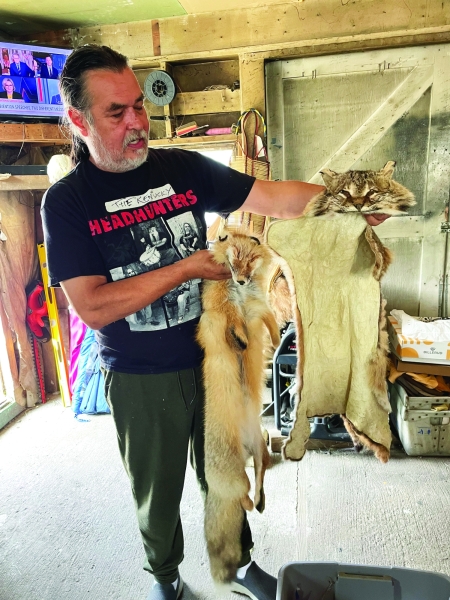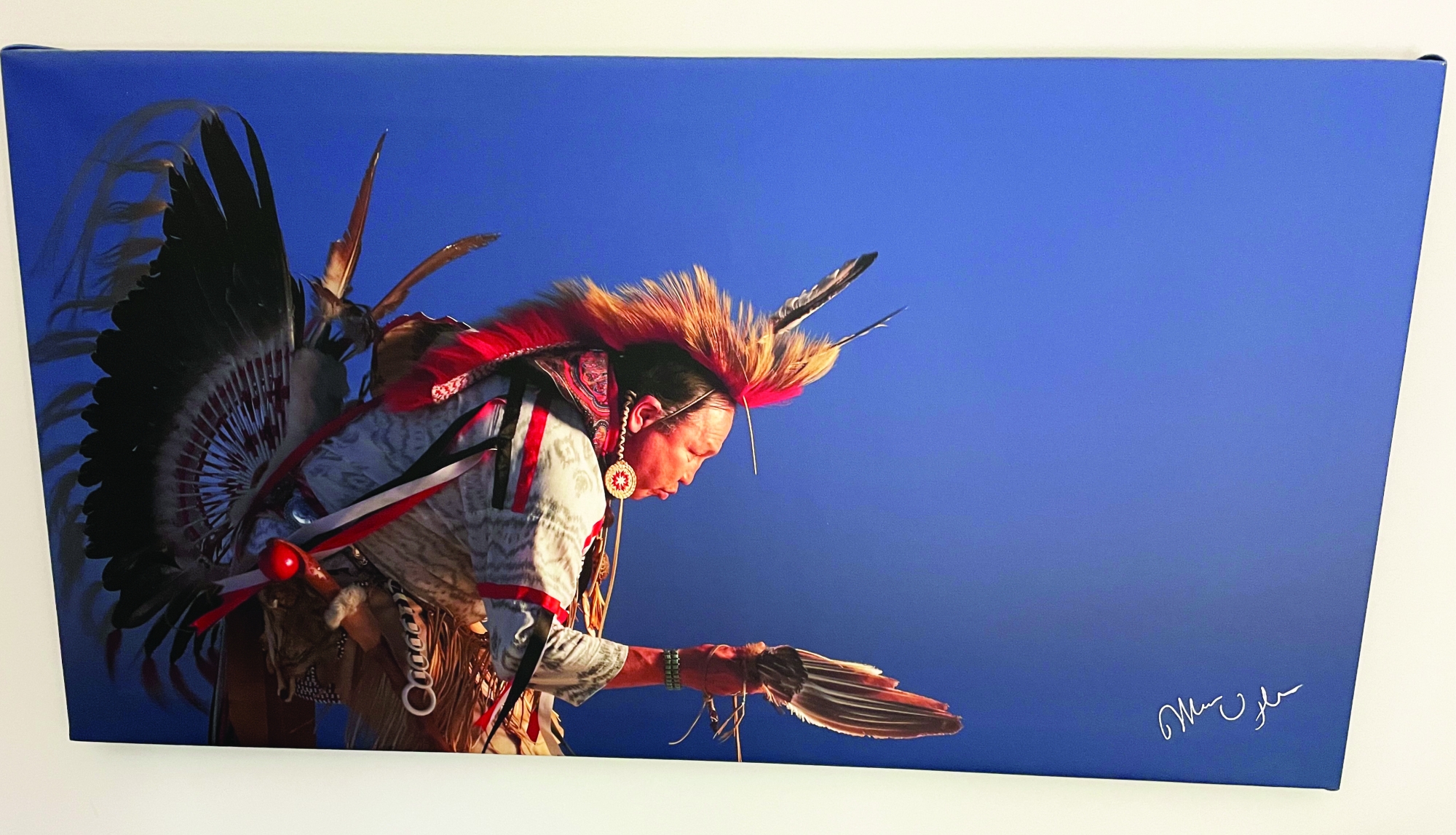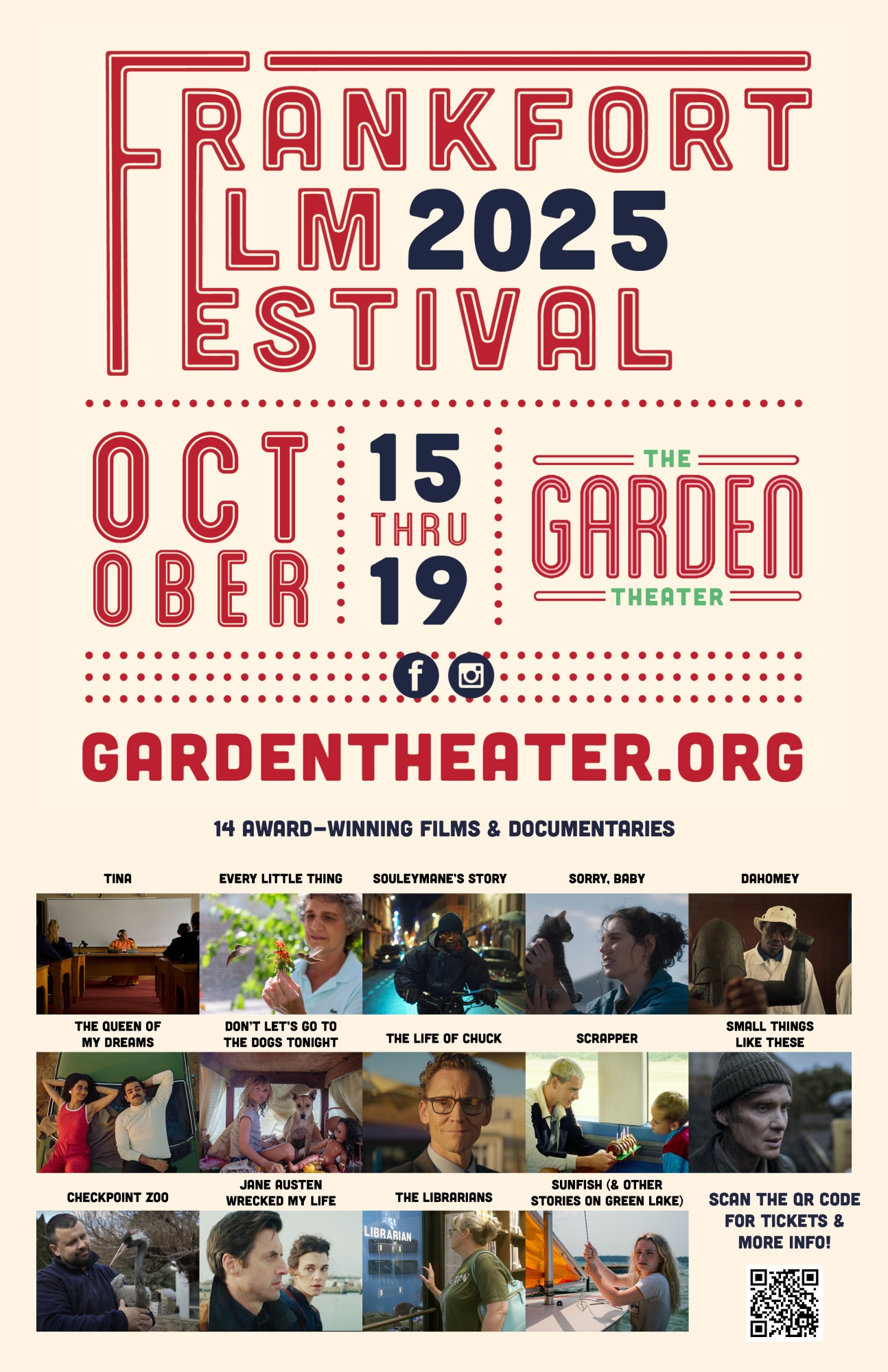Odawa artist extends deceased animals’ purpose “in a good way”
By Tim Mulherin
Sun contributor
On a wall in Hank Bailey’s bedroom is a can’t-miss photographic print on a large canvas. Bailey, an Odawa (Ottawa) elder of the Grand Traverse Band of Ottawa and Chippewa Indians, is the unmistakable subject. He’s in his powwow dancing regalia in a “bending of the knees” pose, as the Anishinaabe word for powwow—Jingtamok—translates.
The picture’s stark blue background, in a shade of early twilight, is a perfect contrast against Bailey’s decoratively attired, side-viewed body, his face illuminated. The fan of raptor feathers in his right hand, the roach headdress made from porcupine guard hairs and deer hair, and the top of the immature bald eagle bustle on his back all practically shimmer in the photographically arranged lighting. His regalia is trimmed in red and black, the colors representing the Black Wolf Clan, his own. Bailey’s appearance is the embodiment of the drum-and-song-accompanied dancing celebration of Anishinaabe identity, culture, and tradition.
In an article Bailey contributed to the Glen Arbor Sun in 2017, he wrote, “I can say without being ashamed that I have been brought to tears during dances. I have felt so good while dancing it seemed like my feet were not even touching the ground.”
Bailey, 75, began dancing in the 1990s as a Traditional dancer. (Other dance styles include Fancy Dance, Grass Dance, Woodland Dance, and women’s Jingle Dress Dance.) His dancing has been reduced due to “just getting old and slowing down.” Nonetheless, he and his wife, Amy, “still try to go” to every Grand Traverse Band powwow.
 After a three-and-a-half-year wait, Bailey received his deceased bald eagle from the National Eagle Repository in Commerce City, Colo. (Through the repository, golden and bald eagle feathers, body parts, or whole birds are made available only to Native Americans.) He “broke the bird down” himself, a skill acquired during his career with the GTB’s Natural Resources Department as an inland fish and wildlife technician. Then he entrusted the eagle’s remains to Odawa artist Fred Raphael, sometime in 2005. Raphael, known nationally among Native American dancers for his regalia designs, assembled Bailey’s roach and bustle.
After a three-and-a-half-year wait, Bailey received his deceased bald eagle from the National Eagle Repository in Commerce City, Colo. (Through the repository, golden and bald eagle feathers, body parts, or whole birds are made available only to Native Americans.) He “broke the bird down” himself, a skill acquired during his career with the GTB’s Natural Resources Department as an inland fish and wildlife technician. Then he entrusted the eagle’s remains to Odawa artist Fred Raphael, sometime in 2005. Raphael, known nationally among Native American dancers for his regalia designs, assembled Bailey’s roach and bustle.
On a late August afternoon in 2024, Bailey served as my guide on an impromptu field trip. It turned out to be a surprise visit with Raphael at his art studio and home in Peshawbestown, which is on GTB reservation land and the location of the band’s tribal headquarters.
Bailey and I pulled up a stool and joined Raphael at his large rectangular worktable. I listened as the two old friends caught up on the latest happenings in the tribe and their families, then turned to Raphael’s recent art projects. When we arrived, he was examining the feathers of a bald eagle killed by a vehicle strike the day before. Then he opened a small freezer to show me the eagle’s head, destined to crown a staff. He then retrieved the refrigerated body of a northern harrier, my favorite hawk species, spreading wide its dark brown-and-white-patterned primary wings for us to fully admire.
Meanwhile, a videotape of a powwow played on the TV above the doorway, with Raphael explaining the types of dances and the respective regalia designed for them. As we were leaving, I asked if I could return sometime for an interview with Raphael about his art. Humbled by my request, he agreed, unsure of why he was worthy of a story. The reasons were all around me.
It’s a sunny and warm late-August Saturday morning in Peshawbestown. I park along the circle in front of Raphael’s home. He’s standing outside, waiting for me. He greets me by saying, “Mino-gigizheb. That’s Anishinaabemowin for ‘good morning.’” We shake hands and I follow him into the studio while repeating the unwieldy term to myself, hoping to imprint it in my faulty memory.
Raphael, 60, is a self-trained artist. His business has no online presence and comes by word of mouth, and there’s no shortage of it. Aside from his regalia-making reputation, his artistic versatility includes being skilled in acrylic painting and stone sculpting, notably working with limestone and alabaster. Among other Anishinaabe artists that influenced his painting style was the famed Norval Morrisseau, from Ontario, whom he knew. The stylistic likeness to Morrisseau’s vividly colored, surreal, mythologically themed artwork in Raphael’s paintings is readily apparent.
The Odawa artist’s studio is dominated by the worktable in the center of the room. To one side is a stack of freezer bags containing raptor feathers. Rolls of various tapes, Gorilla Glue and other adhesives, assorted spray cans, scissors, X-ACTO Knives, a TV controller, disposable lighters, eyeglasses, and a bottle of Vernor’s Ginger Ale are within easy reach. Raphael’s long salt-and-pepper hair is pulled in a tight ponytail, and his gray beard accents his black Kentucky Headhunters T-shirt. His tall, stocky frame gives the impression that he could easily pass for a construction worker, biker, and/or former bouncer. There will be no arm-wrestling challenge from me.
Hanging on a cabinet are several unfinished bustles. Animal parts abound – feathers, bones, skulls, claws, porcupine quills – evidence of artful dissection. He points out two eagle heads mounted on short posts. Slate-and-bluish-black-banded Cooper’s hawk tail feathers lie on another table in an unfinished arrangement. As we talk, he reveals that “M-22 is my trapline.” I laugh initially, then quickly realize how much sense that makes. “Well, not officially, you know, but it really is.”
He doesn’t use songbird feathers in his regalia designs, but he does utilize the yellow-gold, black-tipped tail feathers of yellow-shafted northern flickers. “They’re medicine birds,” he explains. “They’re all over here. Once a year I get one on a roadkill. They’re really sought-after feathers.”
Raphael shows me eagle talons, which find a second life as necklaces, for example. “I have badger claws, wolverine claws,” he adds. Surprised, I ask where the wolverine claws came from. He jumps on my naivete, exclaiming, “From a wolverine!” We both crack up. (Although wolverines are found in the American Northwest and Canada, breeding wolverines have not been seen in Michigan in nearly 200 years.)
Friends and acquaintances will stop along M-22 to pick up raptor roadkill for Raphael. If the birds’ bodies haven’t been mangled, he can typically harvest feathers, talons, and heads to be repurposed for Native ceremonial use (eagle head staffs, for example, are in high demand). Per tribal requirements, Raphael always registers the dead raptors with the GTB’s Natural Resources Department. Later this evening, a contact will be bringing him two goshawks, and Raphael, being Odawa – historically known as traders – will barter for them.
During our conversation, Raphael produces the handsome skin of a bobcat, whose corpse was found on a roadside by a niece, and that of a red fox. The furs may well become key features of some fortunate dancers’ regalia. “The people that come to me know I get [the animals’ remains] in a good way,” he says. Through Raphael’s large, gifted hands, the roadkill is transformed into a dignified afterlife purpose. “That’s respect, right?”
Whenever the time is right, Raphael will walk up to the field behind his home and return the unused raptor and mammal body parts to Mother Earth. The birds of prey feathers will be cast into the wind. Eventually, neighborhood children will come to him with their feathery finds, asking Uncle Fred, as he is known, to identify them. “And I’ll say, ‘Well that’s an eagle feather,’ and they’re just so amazed. Then I teach them about the feather, about how the eagle is the highest-flying bird and can go up to the Creator, to Gitchi Manitou, the Great Mystery.”
Respect indeed.
Tim Mulherin is the author of This Magnetic North: Candid Conversations on a Changing Northern Michigan, published by Michigan State University Press. He is currently writing a book about wildlife in Michigan and Indiana.











